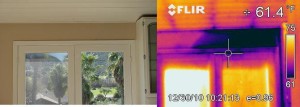Understanding Windows
UNDERSTANDING WINDOWS
Any opening in a building’s envelope – in its outer shell – is technically called fenestration, a term that includes windows, skylights and doors. Obviously, fenestration is important if you’re concerned about energy efficiency. A typical house can lose 30 percent of it’s energy dollars out the windows and doors, according to the California Energy Commission. To put that in perspective – the amount of energy lost through doors and windows in the U.S. every year is roughly equivalent to all the energy we get from the oil carried by the Alaska pipeline! Since windows outnumber doors in most buildings, they deserve the most attention. You can either fix them to make them as efficient as possible, or you can replace them with some of the new technology that has been introduced in the last several decades.Today’s Windows – How They Work
Early windows were little more than holes cut in walls to let light and air into rooms. With the addition of glass in movable frames, a major improvement in building comfort was achieved, allowing closed windows to let in light and block the winter chill. Over the past 20 years, windows have become increasingly more sophisticated, using new materials with more energy-efficient properties. Single-pane glass has been replaced by double, triple and even quadruple panes, with insulating materials separating the layers. Inert gasses have been pumped between the panes, adding to the
window’s insulating properties. Even the glass itself has been coated to reflect heat.
These innovations mean that windows can significantly contribute to a home’s comfort and energy efficiency. By letting in sunlight, they provide warmth in winter, which will
save energy and lower monthly heating bills. Proper design and the use of exterior shading can also lower cooling costs in the summer.
replaced by double, triple and even quadruple panes, with insulating materials separating the layers. Inert gasses have been pumped between the panes, adding to the
window’s insulating properties. Even the glass itself has been coated to reflect heat.
These innovations mean that windows can significantly contribute to a home’s comfort and energy efficiency. By letting in sunlight, they provide warmth in winter, which will
save energy and lower monthly heating bills. Proper design and the use of exterior shading can also lower cooling costs in the summer.
How Energy Flows
To appreciate the improvement in today’s windows, it is helpful to understand three ways that energy can flow through them.- Air can carry heat in or out of a window. Intentional air flow is called ventilation. Unintentional air flow – leakage – is called infiltration.
- Heat – or cold – can flow through the frame and the glass.
- Solar radiation – sunlight – can pass through the glass and can heat whatever is inside the building.



